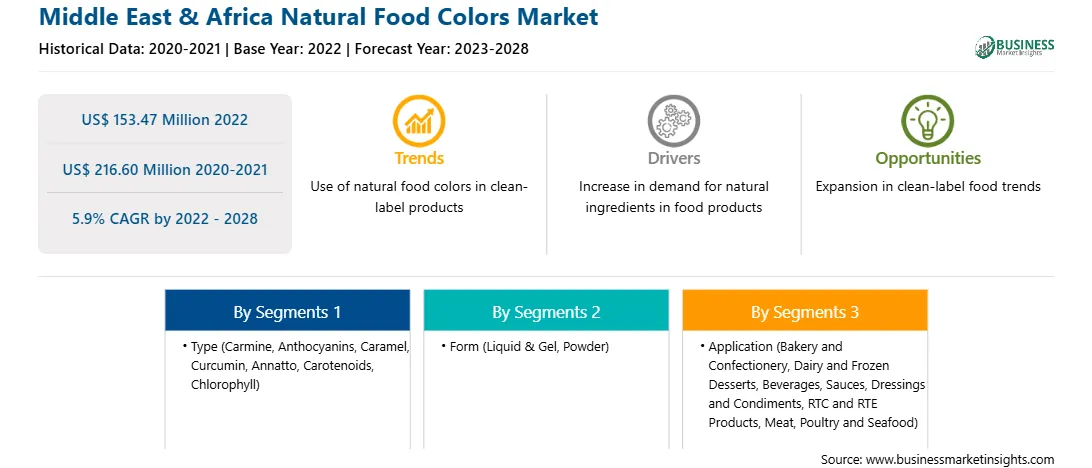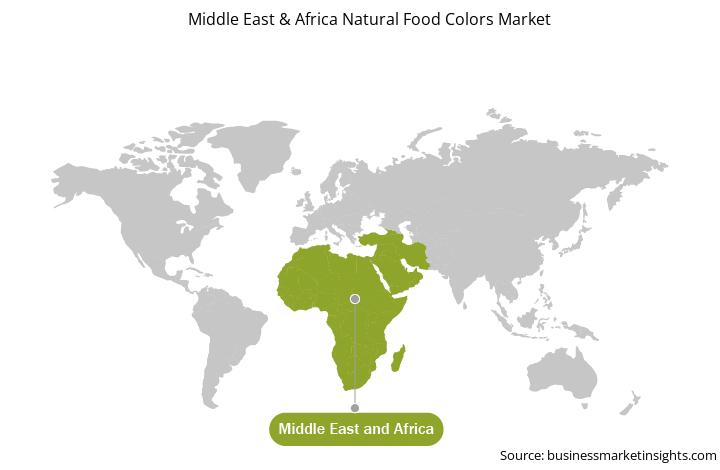The natural food colors market in MEA is expected to grow from US$ 153.47 million in 2022 to US$ 216.60 million by 2028. It is estimated to grow at a CAGR of 5.9% from 2022 to 2028.
Rise in the Number of End-Use Applications
Natural food colors are used in several applications, such as bakery and confectionary, dairy and desert products, beverages, RTE and RTC foods, among others. Along with the rising population in many countries, the demand for bakery and dairy items is also increasing. Moreover, the consumption of beverages is at an all-time high. These factors are positively affecting the use of natural food colors in the market. Natural food coloring is not only used in food and beverage products but is now also used in pharmaceutical and cosmetic products, which increases the scope of its applications. Natural food color is also expected to drive the poultry industry, and dressings & condiments industry’s demands in the coming years. In many regions, RTE and RTC foods have been witnessing high demand owing to factors such as, the rise in working population, and the convenience of availability of such foods. Furthermore, the latest trends of colorful cakes and pastries in the bakery and confectionary segment, has increased the use of natural food colors in the market and is expected to keep growing at a high pace.
Market Overview
Middle East and Africa imports a high amount of natural food colors due to limited industrialization in the region, due to erratic power supply, inefficient road and railway system Moreover, urbanization and growing popularity of beverages and processed meat with natural additives, is expected to boost natural food colors market. Moreover, increasing disposable incomes and ability to spend on exotic and premium food products in Middle East tourist destinations, is also anticipated to increase the natural food color market. According to Natural Food Colors Food Association (NATCOL), the consumer request for natural solutions and products containing natural colorants in Middle East and Africa was 59 % in 2019-2020. The rising natural food trend, along with new legislation of the Gulf Cooperation Council (GCC), introducing labelling criteria for specific synthetic colors, is expected to drive the demand of natural coloring in the region. The demand for processed and convenience foods containing natural ingredients has increased amongst health-conscious immigrant population, in the Middle East countries. Therefore, manufacturers are focused on developing and reformulating food and beverage products with 100 % naturally sourced or clean label ingredients, considering consumer demand.
MEA Natural Food Colors Market Revenue and Forecast to 2028 (US$ Million)
Strategic insights for the Middle East & Africa Natural Food Colors provides data-driven analysis of the industry landscape, including current trends, key players, and regional nuances. These insights offer actionable recommendations, enabling readers to differentiate themselves from competitors by identifying untapped segments or developing unique value propositions. Leveraging data analytics, these insights help industry players anticipate the market shifts, whether investors, manufacturers, or other stakeholders. A future-oriented perspective is essential, helping stakeholders anticipate market shifts and position themselves for long-term success in this dynamic region. Ultimately, effective strategic insights empower readers to make informed decisions that drive profitability and achieve their business objectives within the market. The geographic scope of the Middle East & Africa Natural Food Colors refers to the specific areas in which a business operates and competes. Understanding local distinctions, such as diverse consumer preferences (e.g., demand for specific plug types or battery backup durations), varying economic conditions, and regulatory environments, is crucial for tailoring strategies to specific markets. Businesses can expand their reach by identifying underserved areas or adapting their offerings to meet local demands. A clear market focus allows for more effective resource allocation, targeted marketing campaigns, and better positioning against local competitors, ultimately driving growth in those targeted areas.Middle East & Africa Natural Food Colors Strategic Insights

Middle East & Africa Natural Food Colors Report Scope
Report Attribute
Details
Market size in 2022
US$ 153.47 Million
Market Size by 2028
US$ 216.60 Million
Global CAGR (2022 - 2028)
5.9%
Historical Data
2020-2021
Forecast period
2023-2028
Segments Covered
By Type
By Form
By Application
Regions and Countries Covered
Middle East and Africa
Market leaders and key company profiles
Middle East & Africa Natural Food Colors Regional Insights

MEA Natural Food Colors Market Segmentation
The MEA natural food colors market is segmented into type, form, application and country. Based on type, the market is segmented into carmine, anthocyanins, caramel, curcumin, annatto, carotenoids, chlorophyll, and others. The carotenoids segment registered the largest market share in 2022.
Archer Daniels Midland Company, BASF SE, Döhler Group, DuPont, Givaudan S.A., Koninklijke DSM N.V., Naturex S.A., Oterra A/S, and Sensient Technologies Corporation are the leading companies operating in the natural food colors market in the region.
The Middle East & Africa Natural Food Colors Market is valued at US$ 153.47 Million in 2022, it is projected to reach US$ 216.60 Million by 2028.
As per our report Middle East & Africa Natural Food Colors Market, the market size is valued at US$ 153.47 Million in 2022, projecting it to reach US$ 216.60 Million by 2028. This translates to a CAGR of approximately 5.9% during the forecast period.
The Middle East & Africa Natural Food Colors Market report typically cover these key segments-
The historic period, base year, and forecast period can vary slightly depending on the specific market research report. However, for the Middle East & Africa Natural Food Colors Market report:
The Middle East & Africa Natural Food Colors Market is populated by several key players, each contributing to its growth and innovation. Some of the major players include:
The Middle East & Africa Natural Food Colors Market report is valuable for diverse stakeholders, including:
Essentially, anyone involved in or considering involvement in the Middle East & Africa Natural Food Colors Market value chain can benefit from the information contained in a comprehensive market report.